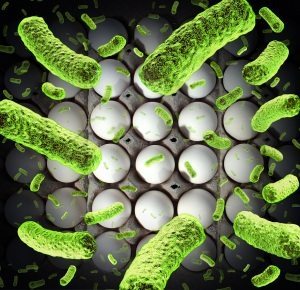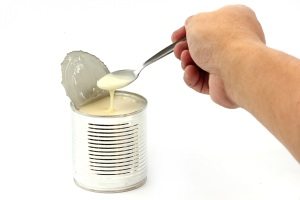
Salmonella Risk in Foods
Contaminants are not added intentionally but can enter food in any stage of food preparation. Contaminants can enter food during production, packaging, transporting or even when in storage. Food can be contaminated even through environmental pollution. Contaminants have a negative impact on human health if they are ingested with food. That is why food safety norms advice testing food for contaminants so that food is safe for human consumption. Three main sources of contamination are from physical, chemical, and microbial sources.
Physical Contaminants
Physical contaminants are substances that become part of a food when mixed in it. Metal filings, stones and mud, glass, packaging material, insects and rodent droppings are all physical contaminants that can harm consumers. Flies can leave dangerous microbes on food when they sit on it. When insects and rodents damage the surface of fruit and vegetable microbes can enter and multiply to spoil food.
Insecticides and pesticides used to control pests and remove insect eggs from crops can cause chemical contamination. If these insecticides and pesticide residues remain on food, they enter the food supply. Tests are often conducted to find out the amount of pesticide residue so that food is safe for human consumption. Chemical contaminants also enter foodthrough water.
Mercury, cadmium, lead, chloroform, benzene, and polychlorinatedbiphenyls (PCBs) are toxins that can get into water and cause health issues if the water used for food preparation is not tested from time to time for these contaminants.
Food is considered to be spoiled when the appearance, texture, flavour and odour change because microbes could have entered the food. These unpleasant changes can lead to foodborne illnesses. Bacteria can multiply into thousands of new bacteria within a day and so food deteriorates very fast if it has been contaminated by microbes. Bacteria, parasites and viruses are all microbial contaminants that cause changes in food.
Chemical Contamination from Food Sources
Chemicals may occur naturally in some foods yet there are other chemicals that can cause hazards if they are present in food or present in higher concentrations than permitted by food safety regulations. Chemical hazards can come from
- Raw foods like mushrooms, green potatoes and even kidney beans are sometimes poisonous but they can become safe with cooking but not always so one has to be careful
- Agricultural produce may be treated with pesticides and fungicides on a farm. Additives in animal feeds and veterinary residues may be present in animal and poultry
- Chemicals and bleaches used for cleaning may contaminate food. Cleaning agents must not be too strong, or wrongly used. Never use unsafe chemicals.
- Petrol and diesel fumes can contaminate food.
- Chemicals should not be transported in the same vehicle that is being used to transport the food articles.
- Metals like cadmium and zinc are used in cookers and fridges. However, these chemicals can cause metal contamination when they come in contact with food. Also when you grease equipment like mixers use only food grade oil to prevent contamination.
- Tin cans made of iron and coated with tin plate. The tin can react with acidic foods canned in them. The reaction causes food to break down and which can then absorb the contamination from the tin. As a precaution once canned food is opened, transfer the contents of the tin into another clean container before refrigerating.
Be Careful of Microbial Contamination
Food becomes contaminated through a variety of other mechanisms. These preventable contaminants can contribute to foodborne illness. Consumers as well as food business operators must be aware of introducing harmful microbes into food without realizing it.

Personal Hygiene – Hand Washing
- Hand washing: Pathogens can be introduced into food from unclean hands or from those humans who are infected with contagious diseases. Fecal matter and dirt inside the fingers can enter food if hands are not properly washed according to food safety norms.
- Cross contamination: This is caused by the transfer of harmful bacteria from one person, object or place to another. Microbes from raw meat and poultry can be transferred from kitchen equipment, utensils, knifes, cutting boards and surfaces if they are not washed adequately between uses. Some contaminants get killed in the cooking process. However, raw fruits and vegetables used for salads must never be cut, sliced or placed on cutting boards used to chop non vegetarian foods since they are eaten raw and could be infected with microbes that cause foodborne illness. Cooked food can be contaminated by other raw foods or drippings from non-vegetarian foods.
- Storage and cooking temperatures: refrigeration or cooking prevents growth of bacteria. Adequate heating of food kills most parasites, viruses and most bacteria and storing at the recommended temperatures prevents microbes from multiplying.
- Contamination through animal waste: During slaughter meat and poultry can be contaminated by small amounts of intestinal contents. Fresh fruits and vegetables can be contaminated if they are washed with water that is contaminated by animal manure or human sewage.
- Shopping: When shopping carry separate plastic bags if you are planning to buy raw meats, poultry and sea foods. These raw meats can contaminate other grocery with juices and drippings if they are not separated.
- Refrigerating Food: Raw meat juices contain harmful bacteria, so keep raw meat, poultry and fish in sealed packets to prevent dripping. Store eggs inside the refrigerator as soon as possible and in their original containers.
- Food preparation and serving: Unless hands, surfaces, cutting boards, utensils and counter tops are cleaned frequently with hot soapy water, bacteria can grow in them. Kitchen cloths must be washed in hot water frequently or they can cause contamination. Use a separate cutting board for fresh fruit and vegetables and raw meat, poultry and seafood to prevent contamination. Immediately replace cutting boards when they have become old or cracked as microbes can enter the cracks. Always serve food in clean plates and dishes. Never place cooked food on a cutting board that had raw food on it earlier as raw food could contain microbes that would then enter the cooked food. Always use a clean cutting board. Wash hands after using bathroom, changing diapers or handling pets.
- Marinate food in the refrigerator and not outside the fridge on the kitchen counter. The sauce used for marinating food can contaminate cooked food so don’t reuse it in other cooked foods.
- Unclean cutting boards can cause contamination when fruits and vegetables are sliced on them before they are cleaned. Fruit and vegetables can get contaminated when
- left too long at room temperatures.
- dirt and grime is not removed from them by washing them
- outer leaves from some vegetables like cabbage and lettuce are not removed

Sweetened Condensed Milk
Tartrazine is a synthetic lemon yellow azo dye derived from coal tar to give food a bright yellow colour. It is used most often to colour sweets, orange drinks, cereals, chips and marmalades. Tartrazine use can lead to problems like anxiety, migraines, skin rashes, thyroid cancer, asthma attacks, blurred vision, clinical depression, attention deficit hyperactivity disorder (ADHD) or hyperactivity, heart palpitations, sleep disturbances, general all-over weakness, hot flushes and OCD (obsessive compulsive disorder. It also affects children’s learning and memory functions besides affecting behaviour. Tartrazine can be replaced with beta-carotene and turmeric to achieve a similar colour but they are more expensive so are not used. Watch out for bright yellow coloured foods.
High-fructose corn syrup (HFCS) is used as a common sweetener. Beware of this ingredient on food product labels as it highly processed and made by using genetically modified ingredients. It is difficult to digest and leads to health problems such as weight gain, dental cavities and poor nutrition, Sodas, cereals, ketchups and salad dressings can contain HFCS.
Diacetyl is another dangerous chemical and is found in microwave popcorn which gets its buttery flavour from it. It is also used in margarine, candies and baked goods. Microwaving popcorn causes diacetyl to vapourise in the bag. This is dangerous and can lead Alzheimer’s, lung damage and a rare, life threatening lung disease, known as bronchiolitis obliterans. Besides the popcorn the bag itself produces perfluorooctanoic acid, which increases the risk of certain tumours.
Metal cans that are lined with bisphenol A (BPA), can pose risk of breast and prostate cancer as well as neurological disorders, infertility, and type 2 diabetes, causes endocrine problems and may increase body fat. Canned foods like soups, fish, gravies, tomato-based products are convenient but may not totally safe. Health scientists advise reduced use of canned food and recommend bottled foods. Also avoid microwaving food in polycarbonate plastic containers as they leach BPA into the food. BPA can also be found in Styrofoam packaging.
Acrylamide is termed as being a carcinogenic agent. It is formed in certain foods when they are heated to high temperatures of over 120°C. Potato chips, doughnuts and fried chicken are highly suspect. This potent neurotoxin adversely affects the brain and the reproductive system. Eating too many deep fried foods increases the risk of prostate cancer. Deep-fried foods contain high levels of advanced glycation endproducts (AGEs), associated with chronic inflammation and oxidative stress when the body cannot detoxify free radicals.
Some of the most contaminated foods
Based on the expert committee report the High Court announced that fruits and vegetables sold in the Capital were unfit for human consumption as 5.3% of vegetables and 0.5% of fruits had pesticide traces above the maximum residue limit. Pesticides like chlordane, endrin, heptachlor, DDT, parathion cause neurological problems, kidney damage, cancer and other diseases Common foods that can get easily contaminated with pesticides are
- Tomatoes and potatoes rank high among vegetables for being highly contaminated with pesticides that are above permissible levels. Spinach on the other hand was found to be contaminated with some of the most dangerous pesticides used to grow food. Celery, red and green bell peppers are other vegetables that are heavily sprayed with pesticides and so they test positive for pesticide residue that are at dangerous levels.
- Meat, pork and poultry are contaminated with the higher levels of pesticides. These pesticides accumulate in the fatty tissues along with animal feed, antibiotics, drugs and hormones administered to animals. Ocean fish are found to be contaminated with heavy metals while fresh water fish with pesticides that has contaminated the water. Milk, cheese and butter are similarly contaminated.
- Strawberries, raspberries and cherries are often sprinkled with several different pesticides ranging from between 25 to 39 pesticides and contamination level ranging from 57% to 90%. Similarly 91% apples and 94% pears tested positive for pesticide residues. Pealing these fruits does not remove the danger of imbibing them. Peaches, nectarines and grapes are all delicate fruit and absorb pesticides more easily.
No comments:
Post a Comment